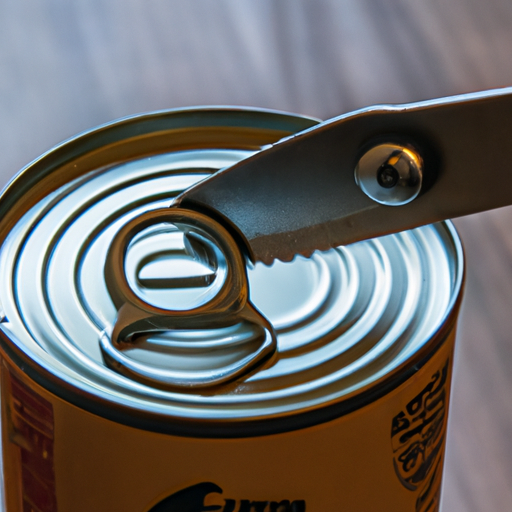In the world of kitchen tools, there is one humble yet crucial companion that often goes unnoticed – the can opener. Whether you’re opening a can of tomato sauce for your pasta or a can of beans for your taco night, having a reliable can opener can make all the difference in your cooking experience. But have you ever stopped to wonder about the science behind this seemingly simple tool? In this article, we will explore the different types of can openers and delve into their efficiency, so you can make an informed choice when it comes to this essential kitchen gadget. Tastepan.com is here to guide you through the fascinating world of can openers, helping you find the perfect one for your culinary needs.

Types of Can Openers
Manual Can Openers
Manual can openers are the traditional and most commonly used type of can opener. They rely on a manual effort to open cans by using a lever mechanism or a wheel and blade mechanism. Manual can openers are portable, versatile, and do not require a power source, making them suitable for outdoor activities or when electricity is not available.
Electric Can Openers
Electric can openers are powered by electricity and provide effortless operation. They are equipped with an electric motor mechanism that automatically opens cans with the push of a button. Electric can openers are quick, efficient, and convenient, especially for those with limited hand strength. They are also ideal for individuals who prefer a hands-free experience.
Safety Can Openers
Safety can openers prioritize the safety of users by incorporating features that minimize the risk of injury. They often have smooth edges, preventing accidental cuts. Some safety can openers also include a magnetic lid holder, which securely holds the lid after it is removed from the can. This prevents potential contact with sharp edges and reduces the chances of cuts or injuries.
Multi-Purpose Can Openers
Multi-purpose can openers offer additional functions beyond just opening cans. They are designed to provide versatility and convenience in the kitchen. These can openers may include built-in accessories, such as a bottle opener or a jar opener, allowing users to save space and have multiple tools in one. Multi-purpose can openers are also compatible with different types of containers, such as cans, bottles, and jars.
Mechanical Principles of Can Openers
Lever Mechanism
The lever mechanism is commonly found in manual can openers. It consists of a handle, a cutting blade, and a pivot point. By applying downward pressure on the handle, the cutting blade pierces the lid of the can and creates a lever effect. This leverage allows for easy rotation and smooth cutting, efficiently opening the can with minimal effort.
Wheel and Blade Mechanism
The wheel and blade mechanism is another mechanical principle used in can openers. It involves a serrated wheel that is rotated along the rim of the can. As the wheel turns, it creates a cutting motion, slicing through the lid of the can. This mechanism is often used in both manual and electric can openers, providing a quick and efficient way to open cans.
Piercing Mechanism
Piercing mechanisms are commonly found in safety can openers. Instead of cutting through the lid, these can openers work by piercing the lid with a sharp, pointed blade. By applying downward pressure, the blade penetrates the lid, creating a safe and controlled opening method. The piercing mechanism reduces the risk of accidental slips, making it a safer option for users.
Electric Motor Mechanism
Electric can openers utilize an electric motor mechanism to automatically open cans. When activated, the motor rotates the cutting blade, which makes a complete revolution around the rim of the can. This automated process eliminates the need for manual effort, providing a convenient and effortless way to open cans.

Efficiency Factors of Can Openers
Ease of Use
The ease of use is an important factor to consider when choosing a can opener. Both manual and electric can openers should have user-friendly designs that allow for smooth operation. Look for can openers with ergonomic handles, comfortable grips, and intuitive mechanisms to ensure a hassle-free experience.
Speed of Operation
The speed of operation is crucial, especially when dealing with multiple cans or time-sensitive cooking preparations. Electric can openers excel in this aspect, offering quick and efficient can opening capabilities. Manual can openers can also provide a fast opening process, depending on the mechanism and the user’s proficiency.
Safety Features
Safety features are paramount to prevent accidents and injuries while using a can opener. Smooth edges on the can opener reduce the risk of cuts when handling cans. Some can openers may also incorporate a magnetic lid holder, automatically grabbing and securing the lid after it is removed from the can. Look for can openers with these safety features to prioritize your wellbeing.
Durability
Can openers should be built to withstand frequent use and last for a long time. Look for can openers made from high-quality materials, such as stainless steel or durable plastics. Additionally, consider the overall construction and design of the can opener to ensure its longevity and resistance to wear and tear.
Compatibility with Different Can Sizes
Different cans come in various sizes and shapes. It’s important to choose a can opener that can accommodate different can sizes, from small tuna cans to larger soup cans. Some can openers are adjustable or have multiple cutting positions, allowing them to handle a wider range of can sizes. This ensures versatility and convenience in the kitchen.
Mechanical Advantage and Cutting Mechanism
Understanding Mechanical Advantage
Mechanical advantage refers to the efficiency gained by using a tool or mechanism to perform a task with less effort. In the case of can openers, the mechanical advantage is achieved through the leverage or rotational motion of the cutting mechanism. A higher mechanical advantage allows for easier and smoother can opening without exerting excessive force.
Importance of Proper Cutting Mechanism
The cutting mechanism is crucial for efficiently opening cans with minimal effort. A well-designed cutting mechanism ensures clean cuts, preventing jagged edges and reducing the risk of accidental cuts. Look for can openers with sharp, sturdy blades or wheels that are capable of smoothly slicing through the lid of the can.
Different Blade Designs
Can openers come with different blade designs to cater to various preferences and can opening requirements. Some can openers have straight blades, which provide a standard cutting motion. Others may feature serrated blades, which offer enhanced grip and cutting precision. Consider the type of blade design that best suits your needs and the types of cans you frequently encounter.

Benefits of Manual Can Openers
Portability and Versatility
Manual can openers are highly portable, making them suitable for outdoor activities, camping trips, or picnics. They do not rely on electricity and can be easily carried and used anywhere. Additionally, manual can openers are versatile, as they can be used with different can sizes and shapes.
No Need for Power Source
One of the significant advantages of manual can openers is that they do not require a power source. This makes them reliable in situations where power outages occur or when there is limited access to electricity. Manual can openers provide a consistent and dependable method of opening cans regardless of the circumstances.
Simple and Easy to Use
Manual can openers are generally straightforward to use, requiring basic hand movements. With a lever or wheel and blade mechanism, users can quickly grasp the operation technique. The simplicity of manual can openers makes them accessible to all users, regardless of age or technical proficiency.
Less Maintenance Required
Manual can openers have fewer components and moving parts compared to electric can openers. This means there is less probability for malfunctions or breakdowns. Manual can openers typically require minimal maintenance, mainly consisting of regular cleaning and occasional lubrication to keep them in good working condition.
Advantages of Electric Can Openers
Effortless Operation
The primary advantage of electric can openers is their effortless operation. With the push of a button, the electric motor mechanism does all the work, requiring minimal effort from the user. Electric can openers are ideal for individuals who may have limited hand strength or dexterity issues, allowing them to open cans with ease.
Quick and Efficient
Electric can openers offer unparalleled speed and efficiency when opening cans. The electric motor quickly rotates the cutting blade around the rim of the can, effortlessly slicing through the lid within seconds. This is particularly beneficial for those who need to open multiple cans or when time is of the essence in meal preparation.
Hands-Free and Convenient
One of the notable advantages of electric can openers is their hands-free operation. After securely attaching the can to the opener, users can simply press a button and let the machine do the work. This allows for multitasking in the kitchen and provides convenience, especially for individuals who have their hands occupied with other cooking tasks.
Suitable for People with Limited Hand Strength
Electric can openers are an excellent option for individuals with limited hand strength or mobility issues. The electric motor mechanism eliminates the need for manually exerting force, reducing the strain on the hands and wrists. This makes electric can openers accessible to a wider range of users, ensuring that everyone can easily open cans without difficulty.
Safety Features in Can Openers
Smooth Edges
Can openers with smooth edges prioritize safety by reducing the risk of accidental cuts or injuries. The cutting mechanisms in these can openers are designed to create smooth edges on the lid, eliminating sharp edges that can pose a hazard when handling them.
Magnetic Lid Holder
Can openers with a magnetic lid holder provide an extra layer of safety. After the lid is removed from the can, the magnetic holder securely grabs and retains the lid, ensuring that it doesn’t fall or come into contact with sharp edges. This prevents potential injuries and keeps the workspace clean.
Automatic Shut-Off
Some electric can openers are equipped with an automatic shut-off feature. After the can is opened, the lid is automatically released, and the can opener shuts off, preventing prolonged operation. This feature ensures energy-saving and reduces the risk of accidents from the continuous rotation of the cutting blade.
Lid Retention Mechanism
Certain can openers have a lid retention mechanism that securely keeps the lid attached to the can opener. This eliminates the need to handle the loose lid, reducing the risk of accidentally dropping or cutting oneself on the lid. Lid retention mechanisms make the can opening process safer and more convenient.
Multi-Purpose Can Openers and Their Versatility
Additional Functions
Multi-purpose can openers are designed to offer more than just can opening capabilities. They often include additional functions that enhance their versatility in the kitchen. These can openers may feature a built-in bottle opener, allowing users to open glass bottles with ease. Some multi-purpose can openers may also include a jar opener, making it convenient to open jars of various sizes.
Built-in Accessories
Multi-purpose can openers may come with built-in accessories that provide added convenience. These accessories can include a knife sharpener, allowing users to sharpen their kitchen knives without needing a separate tool. Other accessories, such as a bag opener or a screw cap opener, can further expand the functionality of the can opener, providing a versatile tool for kitchen tasks.
Compatibility with Different Container Types
Multi-purpose can openers offer compatibility with various types of containers beyond just cans. They can be used to open bottles, jars, and even plastic containers. This versatility eliminates the need for multiple specialized tools, saving space in the kitchen and providing a single tool that can handle multiple tasks.
Innovation in Can Opener Design
Ergonomic Handles
Innovative can openers often feature ergonomic handles that provide a comfortable grip and reduce hand fatigue. These handles are designed to fit the natural contours of the hand, allowing for a more secure and comfortable hold during use. Ergonomic handles improve user comfort and make can opening a more enjoyable experience.
Detachable Parts for Easy Cleaning
Many modern can openers feature detachable parts that can be easily removed for cleaning. This allows for thorough cleaning to maintain hygiene and prevent the buildup of food debris. Detachable parts make it convenient to clean both the cutting mechanism and the handle, ensuring a sanitary and well-maintained can opener.
Non-Slip Grip
Can openers with a non-slip grip provide additional stability during use. The non-slip feature ensures that the can opener remains securely in the user’s hand, even when handling slippery or wet surfaces. A non-slip grip enhances safety, preventing accidental slips or loss of control while opening cans.
Compact and Space-Saving Designs
Innovative can openers often feature compact and space-saving designs. These can openers are designed to be compact and easily stored in drawers or cabinets without taking up excessive space. The compact design also makes them portable, allowing users to bring them on outdoor excursions or store them in small kitchens where space is limited.
Choosing the Right Can Opener for Your Needs
Considerations for Manual Can Openers
When choosing a manual can opener, consider factors such as the mechanism, durability, and grip comfort. Look for a manual can opener with a lever or wheel and blade mechanism that suits your preference and ease of use. Ensure that the can opener is made from high-quality materials that can withstand frequent use. Lastly, test the grip comfort and ergonomics of the can opener to ensure a comfortable and secure hold during operation.
Factors to Look for in Electric Can Openers
For electric can openers, prioritize features such as ease of use, speed, and safety. Look for an electric can opener with intuitive controls and a user-friendly interface. Consider the speed at which the can opener operates, ensuring that it aligns with your cooking needs. Safety features, such as smooth edges and automatic shut-off, should also be carefully evaluated to ensure a secure and hazard-free can opening experience.
Assessing Safety Features
Safety is of paramount importance when selecting a can opener. Evaluate the safety features of the can opener, such as smooth edges, magnetic lid holders, automatic shut-off, and lid retention mechanisms. Prioritize can openers with these safety features to minimize the risk of accidents and injuries during use.
Determining Efficiency and Durability
Efficiency and durability are crucial factors to consider when choosing a can opener. Assess the speed and ease of operation of the can opener to determine its efficiency in opening cans. Additionally, consider the durability of the can opener by examining the materials used, the overall construction, and any warranties provided by the manufacturer. A durable can opener ensures long-lasting performance and reliability.
Budget and Value for Money
Finally, consider your budget and the value for money that a can opener offers. Determine the features and quality that you require within your budget range. Compare different brands and models to find the best balance between price and functionality. Remember that a higher-priced can opener may provide additional features or enhanced durability, but it’s important to choose one that fits your needs and provides good value for your investment.
In conclusion, can openers come in various types, each offering unique features to cater to different preferences and needs. Manual can openers provide portability, versatility, and simplicity, while electric can openers offer effortless operation and convenience. Safety can openers prioritize the wellbeing of users with features such as smooth edges and magnetic lid holders. Multi-purpose can openers provide additional functions and compatibility with different containers. Innovation in can opener design is focused on ergonomic handles, easy cleaning, non-slip grip, and space-saving designs. When selecting a can opener, consider factors such as ease of use, speed, safety features, efficiency, durability, and value for money. With the right can opener, you can streamline your cooking experience and enjoy the convenience of easily opening cans in a safe and efficient manner.

